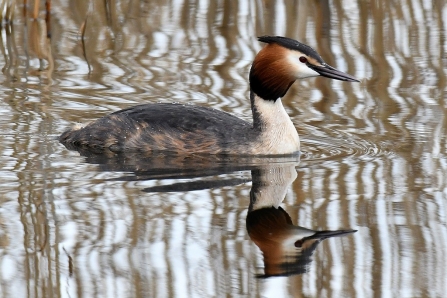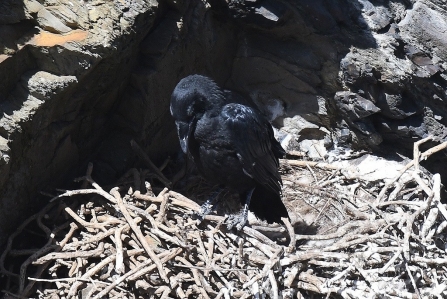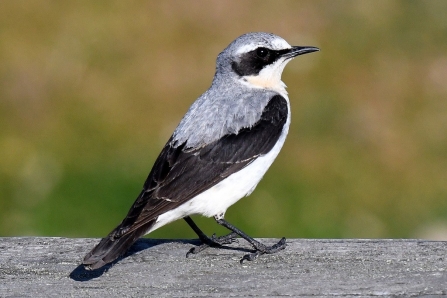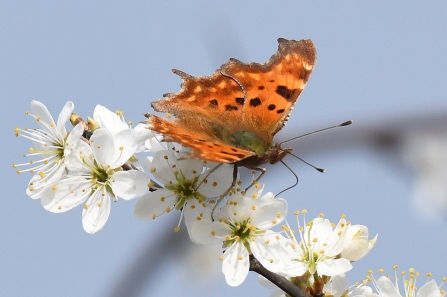Following another mild winter here in the South West, spring is already very much under way. Blackbirds and thrushes are singing loudly to establish their territories.
Wildlife to see in March 2020
Comma butterfly - Chris Chappell

Spotted bee-fly - Chris Chappell
Bees, hoverflies and butterflies are now emerging, the length of the day and some warm sun encouraging their appearance. Look for brimstone and speckled wood butterflies. Male adders are starting to emerge from winter hibernation, the females will appear about two weeks later. Many birds are already building nests, robins and blackbirds may already be sitting on eggs. The pretty yellow lesser celandine and primrose decorate the woodland floors, as the countryside starts to wake.
Herons are early nesters, and they may be found noisily guarding their chosen spot within a tree-top colony. However, a few pairs of have taken to nesting in the reed beds at Shapwick, in individual nests. It is uncertain why some birds have abandoned their colonial instincts, but they seem to do well, raising noisy clacking chicks in April.
By the end of March, sand martins, among the first migrants to arrive from Africa, will appear. The smallest hirundine, white and brown in colour, huge flocks may be seen over the Somerset levels, feeding on flying insects before dispersing around the country. They will be followed around two weeks later by house martins and swallows. The very striking wheatear will normally arrive early in March, and will been seen on the Somerset coast as they arrive.

Goldcrest - Chris Chappell
Goldcrest
Our smallest bird, weighing in at just 6g, these birds are often seen feeding restlessly in yew or cypress trees. Often hanging from a branch, they are searching for small spiders and insect larvae attached to the underside of the leaves. Their call is a short series of very high pitched notes that not everyone can easily detect. They are delightful olive coloured birds, with a white wing stripe, a black stripe and a yellow crest, which conceals a bright orange section in the males, only visible when the male is displaying or alarmed.
They build an exquisite cup shaped nest of moss, cobwebs and lichens, anchored firmly in a yew or evergreen, and lined with hair and small feathers. Laying a clutch of 6-8 tiny eggs, these will hatch within 10 days or so and the parents will be kept busy until their brood has fledged.
On the levels
Bitterns are already starting to call on the levels, their loud boom resonating across the reed beds, the volume increasing over time as their throat muscles build up. If you are lucky, you may see a male chase a female, circling in pursuit for some long time. They are not the most elegant birds in flight, and tend to land clumsily with huge feet outstretched. But their remarkable camouflaged plumage is superb for blending into the reeds. They are a major success story in conservation terms, having naturally repopulated the Somerset reed beds provided for them, and the population has risen from zero to nearly 50 calling males in just ten years. The county now hosts the largest population in the UK.

Great crested grebe - Chris Chappell
Bats are emerging from hibernation, and may be spotted in daylight seeking to take on some food after the winter. Frog and toad spawn appears in ponds. Dunnocks will trill noisily from the tops of hedgerows. Rowdy rooks are busy rebuilding their communal nest sites after the ravages of winter. Therefore there is a lot to look out for, and many good reasons to explore the county as the days lengthen, and the sun warms the ground.
Blackthorn is beginning to burst into flower, the bare branches covered in prolific blossom, while goat (or pussy) willow will produce their characteristic furry flower heads.
You may see brown hares chasing each other in the fields, sometimes 'boxing', while rearing up on their hind legs. These contests involve the does (or jills) seeing off an over-attentive buck (or jack), when they are not ready to mate. These pursuits may erupt suddenly, a group may appear to be feeding quietly when there is a sudden burst of activity.

Raven chick - Chris Chappell
Raven
Our largest corvid, the raven has made a remarkable recovery over recent years, and the regular call 'cronk-cronk' is often heard overhead. They like to nest in cliffs and crags where possible, but in Somerset they are more likely to choose a large tree, a pines and sequoia providing deep cover for the nest.
The raven is a large bird, the size of a buzzard, weighing up to 2kgs. They are acrobatic in flight, and can be distinguished from crows by the diamond shaped tail. They lay a clutch of four or five eggs, secure in a huge nest of twigs, lined with moss and wool. Ravens are long lived, up to 15 years, and will re-use the same nesting site year after year.
Migrating Birds
March sees major movements of migrant birds, from goldcrests to greylag geese, as the wintering population starts to leave our shores for their breeding grounds further north and east. In turn the influx of summer visitors will start from the south. On the levels, the winter ducks and waders will also start to leave, heading north and east for their breeding grounds. Migrant starlings, thrushes and jays will also disperse. Large flocks of woodpigeons head back to eastern Europe. But as they depart, our summer visitors will begin to appear.

Male wheatear - Chris Chappell
One of the first birds to arrive is the wheatear, a striking bird with grey, chestnut and black, and a noticeable white rump. The wheatear is fairly approachable, and can be seen along southern shores, often feeding on flies on the tideline seaweed. Bridgwater Bay is a good place to find them, and they arrive from the second week of the month on.
Our resident noisy Cetti's warbler is joined by chiff chaffs and willow warblers, plus blackcaps, albeit a few these species increasingly over-winter here. Initially migrant arrivals concentrate on finding food to build up their weight after the journey. You may see mixed warblers clustered around a sheltered pond where there is a good source of early flying insects
Blackbird, Song Thrush and Mistle Thrush
Blackbirds have a lovely melodic song, some say the best, and they will be heard singing from a high point, the cock bird claiming his territory at dawn and dusk, challenging any rivals. You may hear several singing in competition in your town or village. They are well adapted to suburban gardens, taking advantage of food, shelter, and shrubs and bushes for nesting sites. The song thrush population seems to have made something of a recovery, having become rather scarce in recent years. The song thrush will perch up in a tree, and their song is quite distinctive, repeating short phrases two or three times, but at best this pattern becomes quite fluid, and very musical. The thrush has a great liking for snails, and often uses a favourite stump or rock to break their shells. The larger and rarer mistle thrush has a loud and rather tuneless flutelike song, repeating longer phrases than the song thrush, they are often heard on heavy cloudy days, when rain is imminent, and have a traditional country name of storm cock.

Comma butterfly - Chris Chappell

